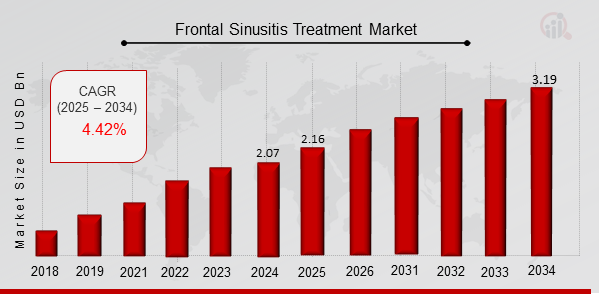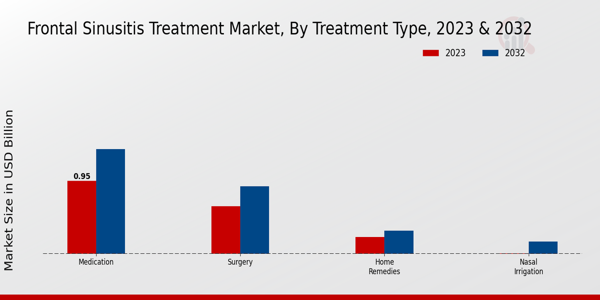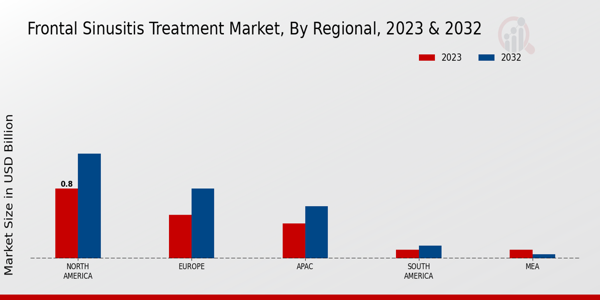Frontal Sinusitis Treatment Market Overview
As per MRFR analysis, the Frontal Sinusitis Treatment Market Size was estimated at 2.07 (USD Billion) in 2024. The Frontal Sinusitis Treatment Market Industry is expected to grow from 2.16 (USD Billion) in 2025 to 3.19 (USD Billion) till 2034, at a CAGR (growth rate) is expected to be around 4.42% during the forecast period (2025 - 2034).
Key Frontal Sinusitis Treatment Market Trends Highlighted
The Frontal Sinusitis Treatment Market has been significantly influenced by several key drivers. An increasing prevalence of sinusitis among the population is a major factor contributing to market growth. Factors such as rising pollution levels, changing lifestyle patterns, and allergies are elevating the incidence of chronic respiratory conditions, leading to a heightened demand for effective treatment options. Moreover, advancements in medical technology and the development of novel therapies have made treatment more accessible and effective, further propelling the market forward. There are numerous opportunities to be explored within the market.Emerging markets present a substantial avenue for growth, as increasing healthcare access and awareness can lead to higher treatment rates. Additionally, the integration of telemedicine is opening new channels for patient engagement and treatment adherence, which can enhance the overall treatment experience. Companies focusing on research and development to discover innovative therapies or improved delivery mechanisms can capture significant market share. Collaborations between medical professionals and tech companies can lead to advanced solutions tailored to patient needs. Recent trends in the market include a growing focus on personalized medicine.Patients are increasingly seeking treatments tailored to their unique conditions, which is pushing companies to develop targeted therapies. Additionally, there is a notable shift towards minimally invasive procedures, which promise quicker recovery times and less discomfort for patients. Patients' preference for outpatient settings is also changing how treatments are administered. As the market continues to evolve, stakeholders must adapt to these trends to remain competitive and meet the changing demands of patients seeking effective solutions for frontal sinusitis.

Source: Primary Research, Secondary Research, MRFR Database and Analyst Review
Frontal Sinusitis Treatment Market Drivers
Rising Incidence of Sinusitis
The Frontal Sinusitis Treatment Market is witnessing significant growth primarily due to the increasing prevalence of sinusitis conditions across the globe. Various factors contribute to this rise, including environmental changes, urbanization, and lifestyle modifications. The modern world has seen a spike in pollution and allergens that can exacerbate sinus problems, leading to a surge in diagnosed cases of frontal sinusitis. Additionally, the rise in respiratory infections and illnesses, amplified by viral infections, is pushing more individuals toward seeking treatment options for sinusitis.As more patients are diagnosed with frontal sinusitis, the demand for efficient treatment solutions has escalated. This trend is expected to continue into the coming years, driving investments in research and development for novel treatment methodologies and thereby enhancing the Frontal Sinusitis Treatment Market industry. The growing awareness among healthcare professionals and patients about the management of sinusitis, coupled with active government initiatives, is instrumental in promoting treatment options.Furthermore, advancements in diagnostic technologies have made it easier for healthcare providers to identify sinusitis, leading to timely intervention and thus increasing the overall treatment market size.
Advancements in Medical Technology
Technological innovations in healthcare are significantly impacting the Frontal Sinusitis Treatment Market. The introduction of minimally invasive surgical techniques and improved diagnostic tools has revolutionized the treatment landscape for frontal sinusitis. Enhanced imaging technologies, such as CT scans and MRIs, allow for more precise diagnosis and treatment planning, which elevates the effectiveness of therapies. Additionally, the development of new medications, including biologics and targeted therapies, has expanded treatment options significantly.These innovations not only improve patient outcomes but also drive demand for newer, more effective therapies in the market.
Growing Awareness and Education
There is a rising awareness regarding frontal sinusitis and available treatment options, which is further propelling the growth of the Frontal Sinusitis Treatment Market. Patients are becoming more informed about the symptoms of sinusitis and the importance of seeking medical help early. Public health campaigns focusing on respiratory health contribute to enhanced understanding and management of sinusitis conditions. This increasing knowledge base equips patients to make more informed decisions about their treatment pathways, hence stimulating market growth as more seek solutions for their sinus issues.
Frontal Sinusitis Treatment Market Segment Insights:
Frontal Sinusitis Treatment Market Treatment Type Insights
The Treatment Type segment of the Frontal Sinusitis Treatment Market plays a crucial role in delivering effective solutions for this prevalent condition. In 2023, the market is valued at 1.9 USD Billion and demonstrates a diverse structure with four primary approaches: Medication, Surgery, Home Remedies, and Nasal Irrigation. Among these, Medication holds the majority share, with a valuation of 0.95 USD Billion, reflecting its significant role as a first-line treatment option. This dominance is attributed to the widespread availability and effectiveness of pharmaceutical solutions, ranging from antibiotics to antihistamines, which cater to varying severity levels of sinusitis.Surgery, valued at 0.62 USD Billion in 2023, is another critical component, often considered when other treatments fail to provide relief. Surgical methods can provide long-term solutions for patients with chronic or severe cases of frontal sinusitis. Home Remedies follow, with a market value of 0.22 USD Billion, highlighting their growing acceptance among patients seeking alternative treatments due to their accessibility and holistic approach. Nasal Irrigation, though the smallest segment at 0.01 USD Billion, has gained traction owing to its non-invasive nature and ability to significantly alleviate symptoms.It underscores the trend towards integrating natural solutions in treatment regimens. As the market evolves, opportunities for innovation in each of these treatment types may emerge, driven by ongoing research and the increasing prevalence of frontal sinusitis. With a projected growth trajectory, understanding the nuances within the Treatment Type segment offers valuable insights into the Frontal Sinusitis Treatment Market revenue and overall dynamics, ensuring that the evolving needs of patients are met effectively.

Source: Primary Research, Secondary Research, MRFR Database and Analyst Review
Frontal Sinusitis Treatment Market Medication Type Insights
The Frontal Sinusitis Treatment Market is projected to reach a valuation of 1.9 USD billion in 2023, showcasing significant growth potential within the Medication Type segment. This market encompasses critical treatments such as Antibiotics, Antihistamines, Decongestants, and Corticosteroids, each playing a pivotal role in managing frontal sinusitis. Antibiotics are essential for combating bacterial infections, while Antihistamines help mitigate allergic reactions that can exacerbate sinus issues. Decongestants are widely used to alleviate nasal congestion, ensuring better airflow and drainage, and Corticosteroids reduce inflammation, promoting healing.The prominence of these medications underscores their importance in providing symptomatic relief and improving overall patient outcomes. With the expected market growth driven by the increasing prevalence of sinus infections and rising awareness regarding treatment options, the Frontal Sinusitis Treatment Market statistics reflect a dynamic field ripe for innovation and development. Factors such as an aging population and lifestyle changes contribute to a heightened need for effective frontal sinusitis treatments, presenting both challenges and opportunities within this expanding industry.
Frontal Sinusitis Treatment Market Route of Administration Insights
The Frontal Sinusitis Treatment Market has been experiencing notable growth, with the market projected to reach a value of 1.9 USD billion in 2023. As treatments continue to evolve, the Route of Administration segment plays a crucial role in determining the effectiveness and patient compliance for frontal sinusitis therapies. The primary routes of administration are Oral, Intranasal, and Injectable. Intranasal administration is particularly significant as it allows for rapid drug absorption directly into the sinus cavity, leading to quicker relief and enhanced efficacy.The Oral route remains popular due to its convenience and non-invasive nature, making it the preferred choice for many patients. Injectable treatments, while less common, provide targeted delivery of potent medications for severe cases. Overall, the Frontal Sinusitis Treatment Market segmentation reflects varied patient preferences and the potential for tailored treatment solutions, fostering market growth and adapting to the evolving landscape of sinusitis management. As the industry matures, continuous advancements and innovative approaches within these routes of administration will shape future market dynamics.
Frontal Sinusitis Treatment Market Patient Age Group Insights
The Frontal Sinusitis Treatment Market analysis illustrates a diverse patient age group that contributes significantly to market dynamics. In 2023, the overall market is valued at 1.9 USD Billion and is projected to witness steady growth thereafter. Within the patient age group, each segment plays a crucial role, with adults typically comprising a substantial portion of the market due to a higher prevalence of sinus-related issues linked to lifestyle and environmental factors. Children are also significant as they often experience sinusitis alongside respiratory infections, which necessitates effective treatment strategies.Meanwhile, the elderly population increasingly requires tailored treatment solutions given their susceptibility to chronic sinus conditions, making this segment vital for market growth. This varied distribution not only emphasizes the need for specialized treatments within the Frontal Sinusitis Treatment Market segmentation but also highlights the opportunities for targeted therapies aimed at addressing the unique needs of each age group. Moreover, considering demographic shifts and the increasing awareness of health conditions related to sinusitis, the market is poised for ongoing growth and evolves in response to these trends.With continued innovations in treatment, the Frontal Sinusitis Treatment Market industry is adapting to these patient needs, refining products that cater to its three primary age groups while driving the overall market growth.
Frontal Sinusitis Treatment Market Regional Insights
The Frontal Sinusitis Treatment Market revenue is projected to reach 1.9 USD Billion in 2023, signifying steady growth within the regional segments. North America stands out as a dominant force, holding a market value of 0.8 USD Billion in 2023, and is expected to witness significant growth, reaching 1.2 USD Billion by 2032, largely driven by advanced healthcare infrastructure and high awareness. Europe follows with a valuation of 0.5 USD Billion in 2023, growing to 0.8 USD Billion by 2032, attributed to increasing prevalence rates of sinusitis and the development of innovative therapeutic solutions.The APAC region, while smaller, accumulates 0.4 USD Billion in 2023 and is anticipated to rise to 0.6 USD Billion by 2032, as rising healthcare investments and growing populations propel market demand. South America and MEA exhibit lower valuations of 0.1 USD Billion and 0.1 USD Billion in 2023, respectively, showing modest growth with projected values of 0.15 USD Billion and 0.05 USD Billion by 2032, indicating the emerging market potential. The uneven distribution of market size suggests opportunities for healthcare providers and pharmaceutical companies to expand their reach in less saturated regions globally.

Source: Primary Research, Secondary Research, MRFR Database and Analyst Review
Frontal Sinusitis Treatment Market Key Players and Competitive Insights:
The Frontal Sinusitis Treatment Market is characterized by a diverse landscape of pharmaceutical companies striving to address the persistent challenges associated with frontal sinusitis, a condition that significantly impacts patients' quality of life. This market encompasses various treatment modalities, including antibiotics, antihistamines, corticosteroids, and surgical interventions aimed at alleviating symptoms and fostering recovery. As healthcare systems evolve and the demand for efficient treatments increases, companies are adopting innovative strategies to stand out. Advancements in drug formulations, an emphasis on patient-centric approaches, and a focus on expanding market reach through strategic partnerships and acquisitions are some of the hallmarks of competition in this space. Market players are also keenly aware of the regulatory environment and the need for compliance, which influences their research and development initiatives.Teva Pharmaceutical Industries is a recognized player in the Frontal Sinusitis Treatment Market, leveraging its extensive experience and robust portfolio to cater to the needs of patients suffering from this condition. The company's emphasis on research and development underpins its commitment to delivering effective therapies. By investing in cutting-edge technologies and a pipeline of innovative treatments, Teva seeks to strengthen its position in this niche market. The organization's global presence enables it to distribute its products widely, ensuring accessibility for patients across different regions. Moreover, Teva's focus on maintaining a competitive edge through strategic collaborations and partnerships enhances its ability to respond to the evolving needs of healthcare providers and patients alike. This approach not only augments its brand reputation but also contributes to the overall growth of the frontal sinusitis treatment sector.Lupin Pharmaceuticals plays a vital role in the Frontal Sinusitis Treatment Market with its focus on delivering high-quality, affordable medication to meet the rising demand. Known for its strong commitment to research and development, Lupin is continually exploring and developing generic and specialty therapies that target frontal sinusitis and improve patient outcomes. The company's strategic initiatives, including its investments in bioequivalent products, position it well to benefit from market trends that favor cost-effective treatment options. Lupin's extensive distribution network and established relationships with healthcare providers enable it to reach a broad patient demographic efficiently. Additionally, the company prides itself on its regulatory compliance and quality assurance, ensuring that its products not only meet but exceed market standards. This strong commitment to innovation and quality enhances Lupin's reputation and solidifies its standing within the competitive landscape of the frontal sinusitis treatment market.
Key Companies in the Frontal Sinusitis Treatment Market Include:
- Teva Pharmaceutical Industries
- Lupin Pharmaceuticals
- Bayer
- Sandoz
- Johnson and Johnson
- GlaxoSmithKline
- AstraZeneca
- Hymed Pharmaceuticals
- Hikma Pharmaceuticals
- AbbVie
- Endo International
- MediNatura
- Merck and Co
- Novartis
- Sanofi
Frontal Sinusitis Treatment Market Industry Developments
The Frontal Sinusitis Treatment Market has recently witnessed significant developments, notably with companies such as Teva Pharmaceutical Industries, Johnson and Johnson, and Bayer actively pursuing new therapies and product enhancements. Advances in treatment methodologies, particularly in biologics and molecular therapies, have sparked interest in the sector, driven by a growing patient population and increased awareness of sinusitis-related complications. Furthermore, the market is currently experiencing mergers and acquisitions, with AstraZeneca and GlaxoSmithKline exploring strategic partnerships to boost their product portfolios in this therapeutic area. The newly emerging products from Hikma Pharmaceuticals and AbbVie aim to address unmet medical needs and improve patient outcomes. In terms of market valuation, a healthy growth trajectory is anticipated as innovations continue and regulatory approvals become more favorable, reflecting positively on the operational dynamics of these companies. The competitive landscape remains active, with Sandoz and Merck & Co. also making strides in research and development, emphasizing the ongoing evolution within the Frontal Sinusitis Treatment Market and its implications for healthcare providers and patients alike.
Frontal Sinusitis Treatment Market Segmentation Insights
- Frontal Sinusitis Treatment Market Treatment Type Outlook
- Medication
- Surgery
- Home Remedies
- Nasal Irrigation
- Frontal Sinusitis Treatment Market Medication Type Outlook
- Antibiotics
- Antihistamines
- Decongestants
- Corticosteroids
- Frontal Sinusitis Treatment Market Route of Administration Outlook
- Oral
- Intranasal
- Injectable
- Frontal Sinusitis Treatment Market Patient Age Group Outlook
| Report Attribute/Metric |
Details |
|
Market Size 2024
|
2.07 (USD Billion)
|
|
Market Size 2025
|
2.16 (USD Billion)
|
|
Market Size 2034
|
3.19 (USD Billion)
|
|
Compound Annual Growth Rate (CAGR)
|
4.42 % (2025 - 2034)
|
|
Report Coverage
|
Revenue Forecast, Competitive Landscape, Growth Factors, and Trends
|
|
Base Year
|
2024
|
|
Market Forecast Period
|
2025 - 2034
|
|
Historical Data
|
2020 - 2024
|
| Market Forecast Units |
USD Billion |
| Key Companies Profiled |
Teva Pharmaceutical Industries, Lupin Pharmaceuticals, Bayer, Sandoz, Johnson and Johnson, GlaxoSmithKline, AstraZeneca, Hymed Pharmaceuticals, Hikma Pharmaceuticals, AbbVie, Endo International, MediNatura, Merck and Co, Novartis, Sanofi |
| Segments Covered |
Treatment Type, Medication Type, Route of Administration, Patient Age Group, Regional |
| Key Market Opportunities |
Increased demand for personalized medicine, Rising prevalence of allergic rhinitis, Advancements in minimally invasive procedures, Growth of telemedicine services, Expansion of over-the-counter treatments |
| Key Market Dynamics |
Increasing prevalence of sinusitis, Growing awareness of treatment options, Advancements in therapeutic technologies, Rising healthcare expenditure, Expanding geriatric population |
| Countries Covered |
North America, Europe, APAC, South America, MEA |
Frequently Asked Questions (FAQ) :
The market is expected to be valued at 3.19 USD Billion in 2034.
The expected CAGR for the market is 4.42 % from 2024 to 2034.
North America is projected to dominate the market with a valuation of 1.2 USD Billion by 2032.
The medication segment is expected to be valued at 1.36 USD Billion in 2032.
Major players include Teva Pharmaceutical Industries, Bayer, Johnson and Johnson, GlaxoSmithKline, and Merck and Co.
The surgery segment is expected to reach a value of 0.88 USD Billion in 2032.
The European market is projected to be valued at 0.8 USD Billion by 2032.
The home remedies segment is expected to reach a value of 0.3 USD Billion by 2032.
Emerging trends and advancements in treatment options present growth opportunities in the market.
Nasal irrigation is expected to be valued at 0.16 USD Billion in 2032.

















